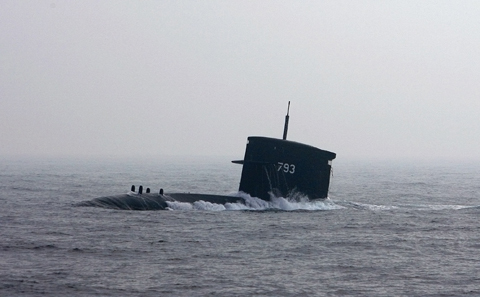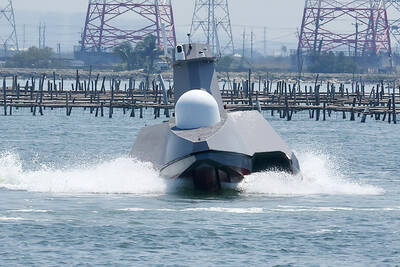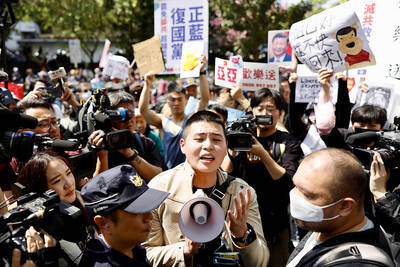With the US stalling on Taiwan’s request to purchase diesel-electric submarines, The Heritage Foundation said in a study that there is now a “submarine arms race” in the Pacific Ocean.
The 13-page study says that since the end of the Cold War, China has dramatically expanded its Navy, especially its submarine fleet, adding dozens of attack subs since 1995.
During the same period, Heritage said, the US attack sub fleet shrank to 53 and is projected to fall to 41 by 2028.

PHOTO: REUTERS
“The US fleet is already stretched thin by the demands of ongoing operations,” the report says. “Australia, India and other Pacific countries have taken note of the shifting balance and have responded with their own naval buildups, particularly of their submarine fleets. Unless the US stops — and reverses — the decline of its own fleet, US military superiority in the Pacific will continue to wane, severely limiting the Navy’s ability to operate in the region, to protect US interests, and to support US friends and allies.”
Concerning Taiwan, the study says it “operates two attack submarines and has explored numerous options to expand and upgrade its submarine fleet, including domestic construction.”
“In 2001, the US offered Taiwan an arms package that included eight diesel-electric submarines, but the US does not own the rights to any current diesel submarine designs and the proposal appears to be dead,” it says.
Some Washington analysts dispute this, however, and suggest that Australia could provide Taiwan with submarine designs.
Australia has six diesel-electric submarines and has announced plans to replace them with 12 modern conventional submarines armed with cruise missiles.
“The Australian government has explicitly tied this expansion to the rise of China as a naval power and weakening US naval supremacy, which Australia believes has played a stabilizing role, especially in the Asia-Pacific region,” the study says.
The study recommends that the Pentagon re-evaluate the use of diesel submarines.
“Congress should direct the Navy to study the utility of using attack submarines,” it says.
“Developing a US conventional submarine capability would facilitate more robust training and afford the US the option to sell advanced diesel submarines to Taiwan,” it says.
The study was written for Heritage by Mackenzie Eaglen and Jon Rodeback, both analysts at the think tank.
“The continuing decline of the US submarine fleet threatens US undersea supremacy in the Pacific and therefore could seriously undermine the Navy’s ability to operate effectively in East Asia and the Pacific,” the report concludes.
Meanwhile, Forbes magazine is predicting that China’s threat to impose sanctions on companies making weapons for Taiwan could be “particularly damaging.”
Four major companies are involved — Raytheon, Boeing, United Technologies and Lockheed Martin.
Boeing and United Technologies are actively operating in China.
“The aircraft industry has been looking to the growing Asian market to rehabilitate sales and revive the industry,” Forbes said.
Global air travel dropped by 2 percent last year, but domestic air travel in China jumped 21 percent.
Boeing estimates that China will need 3,800 new airplanes in the next 20 years at a cost of US$400 billion.
“If China imposes the threatened sanctions, Boeing could lose out on the Chinese market and fall further behind its rival Airbus,” Forbes said.
“The US company is already hurting after several rounds of developmental delays led its 787 Dreamliner aircraft to take its first flight two years behind schedule,” it said.
Raytheon — builder of the Patriot Missile System — has a number of valuable contracts in China, including plans to provide an air-traffic-control system for Shenyang Airport.

ENDEAVOR MANTA: The ship is programmed to automatically return to its designated home port and would self-destruct if seized by another party The Endeavor Manta, Taiwan’s first military-specification uncrewed surface vehicle (USV) tailor-made to operate in the Taiwan Strait in a bid to bolster the nation’s asymmetric combat capabilities made its first appearance at Kaohsiung’s Singda Harbor yesterday. Taking inspiration from Ukraine’s navy, which is using USVs to force Russia’s Black Sea fleet to take shelter within its own ports, CSBC Taiwan (台灣國際造船) established a research and development unit on USVs last year, CSBC chairman Huang Cheng-hung (黃正弘) said. With the exception of the satellite guidance system and the outboard motors — which were purchased from foreign companies that were not affiliated with Chinese-funded

PERMIT REVOKED: The influencer at a news conference said the National Immigration Agency was infringing on human rights and persecuting Chinese spouses Chinese influencer “Yaya in Taiwan” (亞亞在台灣) yesterday evening voluntarily left Taiwan, despite saying yesterday morning that she had “no intention” of leaving after her residence permit was revoked over her comments on Taiwan being “unified” with China by military force. The Ministry of the Interior yesterday had said that it could forcibly deport the influencer at midnight, but was considering taking a more flexible approach and beginning procedures this morning. The influencer, whose given name is Liu Zhenya (劉振亞), departed on a 8:45pm flight from Taipei International Airport (Songshan airport) to Fuzhou, China. Liu held a news conference at the airport at 7pm,

AIR SUPPORT: The Ministry of National Defense thanked the US for the delivery, adding that it was an indicator of the White House’s commitment to the Taiwan Relations Act Deputy Minister of National Defense Po Horng-huei (柏鴻輝) and Representative to the US Alexander Yui on Friday attended a delivery ceremony for the first of Taiwan’s long-awaited 66 F-16C/D Block 70 jets at a Lockheed Martin Corp factory in Greenville, South Carolina. “We are so proud to be the global home of the F-16 and to support Taiwan’s air defense capabilities,” US Representative William Timmons wrote on X, alongside a photograph of Taiwanese and US officials at the event. The F-16C/D Block 70 jets Taiwan ordered have the same capabilities as aircraft that had been upgraded to F-16Vs. The batch of Lockheed Martin

GRIDLOCK: The National Fire Agency’s Special Search and Rescue team is on standby to travel to the countries to help out with the rescue effort A powerful earthquake rocked Myanmar and neighboring Thailand yesterday, killing at least three people in Bangkok and burying dozens when a high-rise building under construction collapsed. Footage shared on social media from Myanmar’s second-largest city showed widespread destruction, raising fears that many were trapped under the rubble or killed. The magnitude 7.7 earthquake, with an epicenter near Mandalay in Myanmar, struck at midday and was followed by a strong magnitude 6.4 aftershock. The extent of death, injury and destruction — especially in Myanmar, which is embroiled in a civil war and where information is tightly controlled at the best of times —